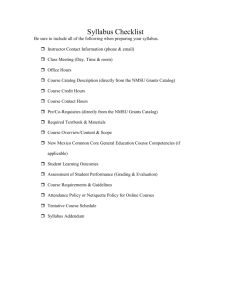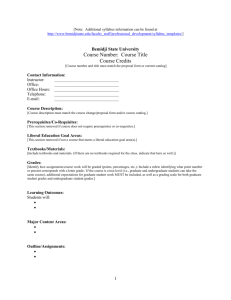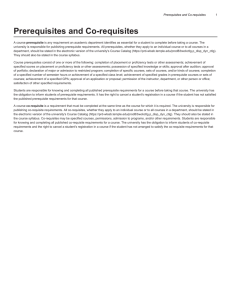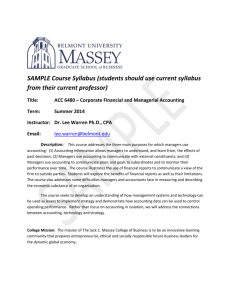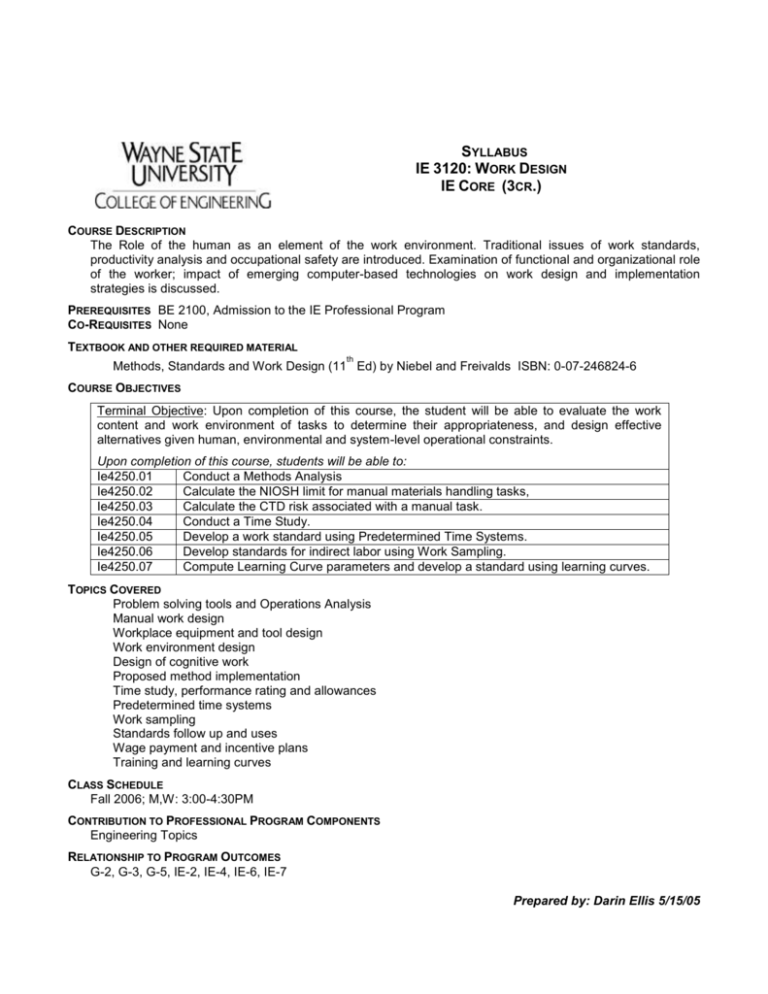
SYLLABUS
IE 3120: WORK DESIGN
IE CORE (3CR.)
COURSE DESCRIPTION
The Role of the human as an element of the work environment. Traditional issues of work standards,
productivity analysis and occupational safety are introduced. Examination of functional and organizational role
of the worker; impact of emerging computer-based technologies on work design and implementation
strategies is discussed.
PREREQUISITES BE 2100, Admission to the IE Professional Program
CO-REQUISITES None
TEXTBOOK AND OTHER REQUIRED MATERIAL
th
Methods, Standards and Work Design (11 Ed) by Niebel and Freivalds ISBN: 0-07-246824-6
COURSE OBJECTIVES
Terminal Objective: Upon completion of this course, the student will be able to evaluate the work
content and work environment of tasks to determine their appropriateness, and design effective
alternatives given human, environmental and system-level operational constraints.
Upon completion of this course, students will be able to:
Ie4250.01
Conduct a Methods Analysis
Ie4250.02
Calculate the NIOSH limit for manual materials handling tasks,
Ie4250.03
Calculate the CTD risk associated with a manual task.
Ie4250.04
Conduct a Time Study.
Ie4250.05
Develop a work standard using Predetermined Time Systems.
Ie4250.06
Develop standards for indirect labor using Work Sampling.
Ie4250.07
Compute Learning Curve parameters and develop a standard using learning curves.
TOPICS COVERED
Problem solving tools and Operations Analysis
Manual work design
Workplace equipment and tool design
Work environment design
Design of cognitive work
Proposed method implementation
Time study, performance rating and allowances
Predetermined time systems
Work sampling
Standards follow up and uses
Wage payment and incentive plans
Training and learning curves
CLASS SCHEDULE
Fall 2006; M,W: 3:00-4:30PM
CONTRIBUTION TO PROFESSIONAL PROGRAM COMPONENTS
Engineering Topics
RELATIONSHIP TO PROGRAM OUTCOMES
G-2, G-3, G-5, IE-2, IE-4, IE-6, IE-7
Prepared by: Darin Ellis 5/15/05
SYLLABUS
IE/ME 3450: MANUFACTURING PROCESSES
IE ELECTIVE (3CR.)
COURSE DESCRIPTION
A study of the field of manufacturing processes from a mechanical engineering design
standpoint. Topics include: processing of metals, polymers and ceramics, and computeraided manufacturing. Material fee as indicated in the Schedule of Classes. (3 Credits)
PREREQUISITES None
CO-REQUISITES ME 2400 Statics and Mechanics of Materials
TEXTBOOK AND OTHER REQUIRED MATERIAL
S. Kalpakjian, S., Schmid, S. R., Manufacturing Processes for Engineering Materials, 4th.
Edition, Addison-Wesley
COURSE OBJECTIVES
A - K. Abbreviations in brackets refer to the methods of evaluation, with HW = Homework,
QE = Quizzes & Exams, PC = Projects or Competitions, PR = Presentations, and RP =
Reports.)
Students who successfully complete ME 3450 will be able to:
1. function effectively within engineering work teams; [PC]
2. analyze metal forming methods as casting, forging, rolling, extrusion and drawing; [QE,
PC]
3. analyze metal machining processes such as cutting, grinding, turning, and drilling; [QE,
PC]
4. analyze assembly processes; [QE, PC]
5. analyze metal joining processes such as welding; [QE, PC]
6. apply equations of metal forming, machining, and joining to estimate capabilities of
metal processing methods; [QE, PC]
7. apply principles and equations of metal forming, machining, and joining to the design of
elements of metal processing structures; [HW, QE, PC]
TOPICS COVERED
Assembly / Design for Assembly
Machining and Grinding
Casting (including Phase Diagram review)
Bulk Deformation Processes – Forging, Rolling, Extrusion, Wiredrawing (including
multiaxial deformation review)
Sheet Metal Processing – Forming, Bending, Shearing
Welding and Joining
CLASS SCHEDULE
Monday and Wednesday, 7:30 – 9:20.
2
CONTRIBUTION TO PROFESSIONAL PROGRAM COMPONENTS
This course contributes 3 credits to the Engineering component of the professional
program.
EXPECTED PROGRAM OUTCOMES
It is expected that by the time of graduation, our BSME students will:
A. be able to understand scientific principles and apply them to the practice of engineering;
B. be able to communicate effectively;
C. possess the problem-solving skills, background, and confidence necessary to educate
themselves continually throughout their careers;
D. be able to apply computers as tools for engineering;
E. be able to apply the basic principles of measurement, data analysis, and design of
experiments, learned through “hands-on” laboratory experience;
F. be able to practice engineering with ethical standards and a sense of responsibility to
society;
G. be able to develop creative solutions to engineering problems;
H. be able to work well as part of a team;
I. be able to apply the design process to engineering problems, including the
consideration of different technical alternatives while bearing in mind cost,
environmental concerns, safety, and other constraints;
J. be able, based on their first-hand design experience, to analyze, construct, test, and
evaluate an engineering design;
K. be able to connect engineering solutions and designs with contemporary issues, and
consider engineering solutions and designs in a global and societal context.
Prepared by: Robin Stevenson, Ph.D. February 10, 2006
3
SYLLABUS
IE 4250: ENGINEERING DATA ANALYSIS
IE CORE (3CR.)
COURSE DESCRIPTION
Advanced concepts for the analysis of variability in engineering problems, multivariate
distributions, hypothesis testing, non-parametric statistics, point and interval estimation,
fitting straight lines, goodness of fit tests, contingency tables and introduction to the
analysis of variance. (4 credits)
PREREQUISITES
CO-REQUISITES
BE 2100, Admission to the IE Professional Program
None
TEXTBOOK AND OTHER REQUIRED MATERIAL
Montgomery, Douglas and Runger, George C., Applied Statistics and Probability for
Engineers, John Wiley & Sons, Third Edition, 2003.
COURSE OBJECTIVES
Terminal Objective: Upon completion of this course, the learner will have an ability to
describe variablitiy in engineering systems, analyze and make inferences using
complex sets of data.
Upon completion of this course, students will be able to:
Statistically model experimental data. (To understand how to model
Ie4250.01
experimental data.)
Describe the importance of “statistical thinking” in industry (To
Ie4250.02
understand the importance of “statistical thinking” in industry. )
Demonstrate a command of visual statistical tools (graphs, charts,
Ie4250.03
tables, etc)
Explain and apply regression analysis (To understand and apply
Ie4250.04
multiple regression analysis.)
Describe the difference between observational studies and design
Ie4250.05 experiments. (To understand the difference between observational
studies and design experiments)
Synthesize factorial designs, conduct data analysis and report
Ie4250.06 results (To understand the synthesis of factorial designs and how to
conduct data analysis and report results.)
Ie4250.07 Develop mastery of a statistical computing package such as Minitab®
TOPICS COVERED
1. The Role of Statistics in Engineering
2. Point Estimation of Parameters
3. Statistical Intervals for a Single Sample
4
4.
5.
6.
7.
8.
9.
10.
11.
Tests of Hypotheses for a Single Sample
Statistical Inference for Two Samples
Simple Linear Regression and Correlation
Multiple Linear Regression
Design and Analysis of Single-Factor Experiments:
The Analysis of Variance
Design of Experiments with Several Factors (1st half)
Nonparametric Statistics
CLASS SCHEDULE
Winter 2006; T,Th: 4:30-5:50PM
CONTRIBUTION TO PROFESSIONAL PROGRAM COMPONENTS
Engineering Topics/Engineering Science
RELATIONSHIP TO PROGRAM OUTCOMES
G-1, G-2, G-3, IE-1, IE-2, IE-6, IE-7
Prepared by: Gary Wasserman; Approved: Curriculum Committee 12/8/05
5
Syllabus IE 4260
Principles of Quality Control
IE Core (3 CR.)
COURSE DESCRIPTION
Advanced concepts for the analysis of variability in engineering problems, multivariate distributions,
hypothesis testing, non-parametric statistics, point and interval estimation, fitting straight lines, goodness of fit
tests, contingency tables and introduction to the analysis of variance.
PREREQUISITES
BE 3220, Admission to the IE Professional Program
CO-REQUISITES: None
TEXTBOOK AND OTHER REQUIRED MATERIAL
Montgomery, Douglas, Introduction to Statistical Quality Control, John Wiley & Sons, Fifth Edition, 2005
COURSE OBJECTIVES
At the end of this course, students will be able to:
Terminal Objective: Have the ability to use process simulation as a tool to enhance organizational
performance in an increasingly complex, turbulent and uncertain business environment.
ie4460.01
To understand the importance of quality and the prevailing quality philosophy in use
today. Describe the importance of “statistical thinking” in industry
ie4460.02
To convey the importance of “statistical thinking” in industry. Explain and apply
regression analysis
ie4460.03
To introduce concepts of common and special cause random variation.
ie4460.04
To understand sampling techniques for assessing product quality.
ie4460.05
To examine advancements in statistical process control over the last 15 years.
ie4460.06
To develop mastery of a statistical computing package such as Minitab®.
TOPICS COVERED
1. Statistics review
2. Minitab
3. Estimation and hypothesis testing continued
4. Quality philosophy
5. Philosophy of SPC
6. Control charts
7. Measurement System Analysis (MSA)
8. Process capability
9. Cusum chart
10. EWMA chart
11. Other univariate process monitoringre
12. Acceptance sampling
CLASS SCHEDULE
Fall 2006; M,W: 3:30-5:00 PM
CONTRIBUTION TO PROFESSIONAL PROGRAM COMPONENTS
Engineering Topics
RELATIONSHIP TO PROGRAM OUTCOMES
IE-1, IE-2, IE-5, IE-6, IE-7
Prepared by: Jayant Trewn
6
SYLLABUS
IE 4310: Production Control
IE CORE (3CR.)
COURSE DESCRIPTION
The design of production planning and control systems. Materials management,
forecasting, planning, scheduling, and maintenance of production systems. Introduction to
the design of computerized materials management systems and supply chain logistics.
Applications of operations research models to production control problems.
PREREQUISITES: Admission to the IE Professional Program, ENG 3050
Co-Requisites: none
TEXTBOOK AND OTHER REQUIRED MATERIAL
Operations Management by William J. Stevenson, Seventh Edition or Eighth Edition,
McGraw-Hill Irwin. ISBN:0072476702
COURSE OBJECTIVES
Terminal Objective: Upon completion of this course, students will be able to describe
the various steps and tradeoffs involved in the design of production planning and
control systems and have working knowledge for contemporary methods and best
practices for manufacturing planning and execution.
ie4310.01 Describe the goals and targets for a production or service system.
ie4310.02 Explain the key steps that must be completed in the design of a
production or service system.
ie4310.03 Participate in a team to analyze and document design issues for a
production system case study.
ie4310.04 For a given situation, choose an appropriate model for management of
raw material, work-in-process, and finished goods inventory.
ie4310.05 Explain the tradeoffs between push and pull production systems in
terms of throughput, lead time, quality, cost, inventory, and equipment
utilization.
ie4310.06 Employ different forecasting tools for modeling demand, including
exponential smoothing and seasonal data forecasting.
ie4310.07 Use linear programming to carryout aggregate planning, capacity
planning, and workforce planning.
ie4310.08 Describe the heuristics available for solving operation scheduling and
sequencing problems.
ie4310.09 Describe the role of maintenance in manufacturing facilities .
ie4310.10 Describe the issues that impact operations management which involve
supply chains.
ie4310.11 Describe the role of information technology in supply chain logistics.
ie4310.12 Demonstrate effective technical writing and communication skills.
TOPICS COVERED
1. Introduction to operations management
2. Design of Production and Service Systems
Establishing Goals and Targets
Process and Technology Selection
7
Process Selection Tool - Decision Tree
Case Analysis: NorthStar Assembly Process and Technology Solution
Capacity Planning
Location Planning
Facilities Layout
Design of Work Systems & Design of People Systems
Validation of Systems Prior to Regular Production
Case Analysis: NorthStar Assembly Process and Technology Solution - Group
presentation
3. Manufacturing Planning & Execution
Inventory Management
Production Planning and Control – MRP, MRP2 & ERP
Just-in-time Production
Production Performance Management
Maintenance Engineering
Manufacturing Strategies for Competitive Advantage
4. Designing, Modeling, and Managing Supply Chains
Operations in Supply Chain Management
Modeling Supply Chains
Relationships & Performance Assessment in Supply Chain Management
CLASS SCHEDULE
M W 05:00PM - 06:25PM
CONTRIBUTION TO PROFESSIONAL PROGRAM COMPONENTS
Engineering Topics
RELATIONSHIP TO PROGRAM OUTCOMES
G-1, G-2, G-3, G-4, G-5, G-6, G-7, IE-1, IE-2, IE-3, IE-4, IE-5, IE-5, IE-7
Prepared by: Ratna Babu Chinnam March 5, 2006
8
SYLLABUS
IE 4330: Facilities Design
IE CORE (3CR.)
COURSE DESCRIPTION
Design of manufacturing, warehouse, and material handling facilities. Use of analytic and
computer-aided methods in the facilities design process.
PREREQUISITES: Admission to the professional IE Program
CO-REQUISITES: None
TEXTBOOK AND OTHER REQUIRED MATERIAL
Tompkins, J.A., White, J. A., Bozer, Y. A., and Tanchoco, J. M. A., Facilities Planning,
Third Edition, John Wiley and Sons, Inc., 2003, ISBN: 0-471-41389-5.
COURSE OBJECTIVES
Terminal Objective: Have the ability to analyze and design manufacturing,
warehouse, and material handling facilities using analytic and computer-aided
methods.
ie4330.01
ie4330.02
ie4330.03
ie4330.04
ie4330.05
ie4330.06
ie4330.07
Define the basic objectives of facility layout, and demonstrate methods
for constructing facilities layouts (IE-2, G-2).
Use factory simulation to plan, analyze, and design a facility (G-2, IE-2,
IE-6).
Select material handling equipment (IE-2, G-2).
Incorporate personnel requirements including accessibility. (G-4, G-8,
IE-4).
Identify current facilities design and location issues with societal impact
such as global outsourcing. (G-4, G-8).
Identify who should be involved in the facility design team and how to
determine what data is needed and where to obtain that data (IE-4).
Work as a member of an engineering team to design a new or redesign an existing facility using the skills developed in this class and
effectively communicate this design in a written and oral report. (G-1,
G-2, G-7, IE-3, IE-6)
TOPICS COVERED
1. Facilities Planning: An Overview
2. Strategic facilitates planning, product, process, and schedule design
3. Planning departments, product, process, cells. Activity relationships, flow patterns and
planning
4. Measuring flow, quantitative and qualitative. Space allocations, aisles
5. Personal requirements. Facilities design and accessibility
6. Systematic Layout planning (SLP) and general algorithmic approaches I
7. Systematic Layout planning (SLP) and general algorithmic approaches II
8. Computer-aided Facilities and overview of software packages
9. Overview of material handling equipment and objectives
9
10. Description of material handling equipment and optimization
11. Location problems
12. Location problems and warehousing
13. Facilities location and global outsourcing issues
CLASS SCHEDULE
Winter 2006: T Th 3:00 PM to 4:30 PM
CONTRIBUTION TO PROFESSIONAL PROGRAM COMPONENTS
Engineering Topics/Design
RELATIONSHIP TO PROGRAM OUTCOMES
G-1, G-2, G-4, G-7, IE2, IE-3, IE-4, IE-6, IE-7
Prepared by: Kyoung-Yun Kim 11/29/05; Approved: Curriculum Committee 12/8/05
10
SYLLABUS
IE 4420: SIMULATION
IE CORE (3CR.)
COURSE DESCRIPTION
Systems modeling and discrete event simulation. Methodology applied to analysis and design of a broad
range of systems including both production and service systems. Computer assignments and a term project
are required.
PREREQUISITES
Admission to the IE Professional Program
CO-REQUISITES
None
TEXTBOOK AND OTHER REQUIRED MATERIAL
Kelton, Sadowski, & Sadowski, Simulation with Arena, 3rd Edition 2003
COURSE OBJECTIVES
At the end of this course, students will be able to:
Terminal Objective: Have the ability to use process simulation as a tool to enhance organizational
performance in an increasingly complex, turbulent and uncertain business environment.
ie4420.01
Identify appropriate correct applications of computer simulation to business and
industrial problems
ie4420.02
Build basic simulation models in ARENA
ie4420.03
Explain the roles and responsibilities of a Process Simulation Analyst
ie4420.04
Collect and analyze simulation input data
ie4420.05
Perform simulation analyses and develop management reports
TOPICS COVERED
1. Introduction to Simulation
2. Fundamental Simulation Concepts
3. ARENA Modeling Concepts
4. Input Data Analysis
5. Random Number and Random Variate Generation
6. Post Simulation Analysis
7. Application Case Studies
CLASS SCHEDULE
Winter 2006: M W 03:00PM - 04:25PM
CONTRIBUTION TO PROFESSIONAL PROGRAM COMPONENTS
Engineering Topics
RELATIONSHIP TO PROGRAM OUTCOMES
G-1, G-2, G-3, G-4, G-5, IE-1, IE-2, IE-4, IE-5, IE-6, IE-7
Prepared by: Olugbenga O. Mejabi 11/18/05 Approved: Curriculum Committee 12/8/05
11
SYLLABUS
IE 4560 Operations Research
IE Core (3cr.)
COURSE DESCRIPTION
An introduction to the philosophy of operations research. Formulation of linear programming models and their solution.
Duality and sensitivity analysis. The transportation model. Introduction to probabilistic modeling and applications of
queueing models.
PREREQUISITES
Admission to the IE Professional Program, MAT 2150 and BE2100
TEXTBOOK AND OTHER REQUIRED MATERIAL
Hillier, F. S. and Lieberman, G. J. Introduction to Operations Research, 8th ed., New
York: McGraw-Hill, 2005
COURSE OBJECTIVES
At the end of this course, students will be able to:
Terminal Objective: Develop educated consumers of deterministic operations research
techniques by exploring a broad range of applications.
ie4560.01
Develop skills in recognizing & formulating deterministic
optimization models including: constraints, objective functions
and decision variables.
Develop an appreciation for the role of sensitivity analysis in
ie4560.02
analyzing a system
ie4560.03
Develop an appreciation for a mathematically based algorithm and
the ability to use off-the-shelf software for setting up models
solving operations research problems.
ie4560.04
Quantify the cost of constraints
ie4560.05
Develop an understanding of the theory behind the models and the
importance of simplifying assumptions. (Linear, integer, network &
non-linear)
ie4560.06
Build a broader understanding of the types of mathematical models
and their appropriate context.
ie4560.07
Work as a member of an Operations Research team to identify,
analyze, formulate and solve a business case problem and
effectively justify your model and solution in a written and oral
report.
TOPICS COVERED
CLASS SCHEDULE
Winter 2006: M W 1:00pm to 2:30 pm
CONTRIBUTION TO PROFESSIONAL PROGRAM COMPONENTS
Engineering Topics
RELATIONSHIP TO PROGRAM OUTCOMES
12
G1, G2, G-3, G-7, IE-2, IE-4, IE-4, IE-6, IE-7
Updated by Alper Murat 10/4/2006
13
SYLLABUS
IE 4800/4880
Engineering Design Project II
IE Core (2cr.)
COURSE DESCRIPTION
Intensive design experience defined and executed by the student. Requires synthesis and application
of skills and knowledge gained in the program.
PREREQUISITES
Written consent of instructor. Open only to students enrolled in professional engineering programs.
CO-REQUISITES
TEXTBOOK AND OTHER REQUIRED MATERIAL
Course materials on Blackboard site.
COURSE OBJECTIVES
Students will demonstrate professional engineering problem-solving behavior through teamwork, the
application of skills learned in the curriculum, the ability to extend learning to new situations, and the
integration of knowledge to solve a real-world system design problem.
At the end of this course, students will be able to:
Terminal Objective: The ability to apply principles of Industrial Engineering to the design of
processes, systems, and facilities that serve the needs of people and industry.
Ie4880.01
Understanding of methods for determining the requirements, identifying needs of
customers, and translating these into a functional designs.
Ie4880.02
The ability to perform analyses required for evaluation of process design and
improvement alternatives using tools such as simulation, business case and cost
analysis, and value stream analysis.
Ie4880.03
The ability to use computers as a communication, computation and design tool in the
context of process design and improvement.
Ie4880.04
The ability to clearly and succinctly document and communicate process design ideas
and concepts for the intended users of design information.
Ie4880.05
The ability to function as a part of an engineering team
Ie4880.06
Demonstrated ethical behavior in the conduct of the project.
Ie4880.07
An ability to extend knowledge and skills needed to conduct the project without formal
instruction.
TOPICS COVERED
Varies by project, covering the potential range of IE topics.
CLASS SCHEDULE
Winter 2006: F 1:00pm to 5:00 pm
CONTRIBUTION TO PROFESSIONAL PROGRAM COMPONENTS
Engineering Topics
RELATIONSHIP TO PROGRAM OUTCOMES
G-1, G-4, G-6, G-7, IE-2, IE-3, IE-4, IE-6
Updated by Darin Ellis 10/9/2006
14
SYLLABUS
IE/CE 4850: ENGINEERING ECONOMY
IE CORE (3CR.)
COURSE DESCRIPTION
Economic analysis of engineering projects. Application of appropriate interest rates and
methods of analysis for comparing and choosing among investment alternatives. Effect of
depreciation and income taxes on rate-of-return calculations and use of accounting data in
comparing investment alternatives. (3 credits)
PREREQUISITES
Students must be enrolled in a professional engineering program.
CO-REQUISITES
NONE
TEXTBOOK AND OTHER REQUIRED MATERIAL
Grant, Ireson & Leavenworth, Principles of Engineering Economy, Wiley, Inc.,8th Edition.
COURSE OBJECTIVES
At the end of this course, students will be able to:
Prepare and interpret a cash flow diagram
Understand, calculate and apply nominal and effective interest rates
Compute the present worth, annual worth and future worth of a cash flow time series
Evaluate investments based on present worth, annual worth, rate-of-return and
benefit-cost ratio
Calculate depreciation using straight-line, sum-of-the-years-digits and declining
balance methods
Calculate before tax and after tax rate-of-return on investment options
Calculate and interpret expected values for comparing investments under conditions
of uncertainty
Prepare and apply decision trees for making choices under conditions of uncertainty
Understand the importance of engineering economy principles to personal financial
management
TOPICS COVERED
Relationship and implications of engineering economy to personal financial management
Interest rates, borrowed money and repayment alternatives
Single payments, uniform annual payments, gradient series
Present worth, annual worth, future worth
Rate of return
15
Benefit-cost ratio
Depreciation and income tax impact on investments
Expected values and decision trees
CLASS SCHEDULE
Tuesdays and Thursdays, 3:00pm – 4:20pm
CONTRIBUTION TO PROFESSIONAL PROGRAM COMPONENTS
Prepares students to properly apply mathematics and principles of engineering economy in
analyzing and solving modern engineering problems. Provides students with skills needed
to evaluate the economic implications of investment decisions and engineering design, as
well as personal financial management.
RELATIONSHIP TO PROGRAM OUTCOMES
Allows students to build proficiency with respect to the following general outcomes:
A. An ability to apply knowledge of mathematics, science, and engineering.
E. An ability to identify, formulate, and solve engineering problems
J. Knowledge of contemporary issues within and outside the context of engineering.
K. Demonstrate proficiency in using modern engineering tools.
PREPARED BY:
JANUARY 20, 2006
THOMAS M. HEIDTKE, Ph.D. DATE:
16
SYLLABUS
IE 5995: Labor Relations in Manufacturing
IE ELECTIVE (3CR.)
CREDITS: 3cr.
COURSE DESCRIPTION
This course provides an overview of the U.S. labor relations system with particular emphasis on contract
administration and the changes occurring in labor relations practice as a result of increasing competition and
new production systems.
PREREQUISITES: Admission into the IE professional program
CO-REQUISITES: None
TEXTBOOK AND OTHER REQUIRED MATERIAL
John Budd, Labor Relations: Striking a Balance.
New York: McGraw-Hill, 2005.
OBJECTIVES
At the end of this course, learners will be able to:
ie5995L.01
ie5995L.02
ie5995L.03
ie5995L.04
ie5995L.05
ie5995L.06
ie5995L.07
Understand and apply legal framework which regulates labor-management relations
Understand and administer the collective bargaining agreement
Understand and apply the grievance-arbitration system
Understand and apply strategies for preventing and resolving grievances
Understand and apply the implementation and institutionalization practices involved in
establishing and maintaining a constructive labor-management relationship
Describe the changes occurring in labor-relations practice in response to intensifying
competition and new production systems
Describe the similarities and differences between the U.S., Japanese and German labor
relations systems
TOPICS COVERED
1. The Triumph of Mass Production
2. The New Deal Industrial Relations System
3. Labor and Management Strategies, Structures and Rights
4. Contract Clauses and Their Impact
5. The Grievance Procedure
6. Grievance Arbitration
7. Collective Bargaining
8. Bargaining Simulation
9. Impasse, Strikes and Dispute Resolution
10. The U.S. Industrial Relations System Under Stress
11. Flexibility and Employee Involvement
12. Union Organizing
13. International Comparative Labor Relations
CLASS SCHEDULE: Winter 2006: Th 06:00PM - 08:45PM
CONTRIBUTION TO PROFESSIONAL PROGRAM COMPONENTS
ENGINEERING TOPICS
Revised by: Hal Stack 5/5//2006
17
SYLLABUS
IE 5995: Leadership in the Workplace
IE ELECTIVE (3CR.)
CREDITS: 3cr.
COURSE DESCRIPTION
This course provides the knowledge and skills to effectively lead individuals and teams in a unionized
workplace.
PREREQUISITES: Admission into the IE professional program
CO-REQUISITES: None
TEXTBOOK AND OTHER REQUIRED MATERIAL
David Whetten and Kim Cameron, Developing Management Skills. Pearson Prentice Hall, 2005.
OBJECTIVES
At the end of this course, learners will be able to:
ie5995L.01
ie5995L.02
ie5995L.03
ie5995L.04
ie5995L.05
ie5995L.06
ie5995L.07
ie5995L.08
ie5995L.09
ie5995L.10
Increase tactical self awareness and emotional intelligence
Understand and appreciate individual differences
Communicate supportively
Build teams and enhance teamwork
Analyze and influence employee behaviors
Identify, analyze and solve workplace problems
Manage conflict and negotiate agreement
Plan and implement change
Monitor and manage personal stress and time
Prepare and deliver effective presentations
Topics Covered
1. Developing Self Awareness
2. Managing Personal Stress and Time
3. Solving Problems Analytically and Creatively
4. Coaching, Counseling, and Supportive Communication
5. Gaining Power and Influences
6. Motivating Others
7. Managing Conflict
8. Empowering and Delegating
9. Team Work and Project Team Planning
10. Building Effective Teams
11. Effective Meetings and Presentations
12. Leading Change
CLASS SCHEDULE: Winter 2006: Th 06:00PM - 08:45PM
CONTRIBUTION TO PROFESSIONAL PROGRAM COMPONENTS
Engineering Topics
Revised by: Hal Stack 5/5//2006
18
SYLLABUS
IE 5995: Information Technology
IE ELECTIVE (3CR.)
COURSE DESCRIPTION
Information systems provides an environment that allows an engineer to consider both product and
manufacturing requirements throughout the design, development, manufacturing cycle, resulting in
a single unified concurrent engineering process, an integral knowledge management process, rapid
response to market changes, and innovation. This course sets the basic foundation of computer
programming with Visual Basic for Applications (VBA) not just for the purpose of programming
development skills, but for extending the capability of solving complex management science models
and a wide variety of business problems using spreadsheet modeling along with the code that runs
in the background of an application.
PREREQUISITES: Admission into the IE professional program
CO-REQUISITES: None
TEXTBOOK AND OTHER REQUIRED MATERIAL
Albright, Christian Albright, VBA for Modelers—Developing Decision Support Systems with
Microsoft Excel, Second edition, Thomson Brooks Print (Duxbury publishing) ISBN 0-495-10683-8
OBJECTIVES
At the end of this course, learners will be able to:
ie5995I.01
ie5995I.02
ie5995I.03
ie5995I.04
Write computer code using Visual Basic
Develop spreadsheet models
Apply programming to the solution of complex management science problems.
Apply learning to the execution of team-based project.
Topics Covered
VBA Fundamentals
Excel object model and VB editor
Macros and VBA
Control logic and loops
Arrays
Subroutines and Functions
Files and Folders Handling
Import from and export to a database
Pivot table.
Solvers and other and add-ins
Int. to application development with VBA
A blending application
A product mix application
A logistics application
CLASS SCHEDULE: Winter 2006: T, Th 1:25pm – 2:50pm
CONTRIBUTION TO PROFESSIONAL PROGRAM COMPONENTS
Engineering Topics
Prepared by Namkyu Park 5/28/2006
19
SYLLABUS
IE 5995: Manufacturing Processes Laboratory
IE ELECTIVE (1 CR.)
COURSE DESCRIPTION
This course will provide the student with a general understanding of the basic techniques
used in processing raw materials into useful products, and the criteria for selecting
particular processes. The intent is not to turn the student into a skilled technician, but rather
to give him or her an understanding of the various processes and their capabilities, and the
influence of this on part design and process selection.
PREREQUISITES: Admission into the IE professional program
CO-REQUISITES:
None
TEXTBOOK AND OTHER REQUIRED MATERIAL
Albright, Christian Albright, VBA for Modelers—Developing Decision Support Systems with
Microsoft Excel, Second edition, Thomson Brooks Print (Duxbury publishing) ISBN 0-49510683-8
OBJECTIVES
At the end of this course, learners will be able to:
ie5995I.01
ie5995I.02
ie5995I.03
ie5995I.04
ie5995I.05
ie5995I.06
ie5995I.07
ie5995I.08
ie5995I.09
ie5995I.10
ie5995I.11
ie5995I.12
ie5995I.13
ie5995I.14
ie5995I.15
Identify common machines such as the lathe, drilling, milling, grinding
machines.
Identify the cutting tools used on the above machines
Distinguish between the capabilities of the above machines
Operate each of these machines
Identify the important operating parameters for each of these machines
Describe how changes in operating parameters affect the quality of the
part made.
Select the appropriate machine(s) for making various parts
Select appropriate operating parameters for the machine(s)
Identify commonly used inspection equipment on the shop floor
Use gages such as calipers and micrometers to inspect parts.
Inspect a machined part and determine if it meets design specifications
Identify equipment used in MIG and TIG welding
Operate MIG and TIG welding equipment
Describe general safety procedures that need to be followed in a
machine shop
Identify pertinent safety equipment
Topics Covered
Shop Practices: Introduction to the manufacturing lab environment.
Turning: Introduction to the use of a cutoff-saw, grinding of cutting tools, and the
basic machining processes used on a lathe.
Milling: Introduction to the basic machining processes used on a milling machine.
20
Project: The Two-Poster Engine For this project, students will go through the
complete process of making the Two-Poster engine in line with the requirements
given on standard shop drawings. This will require the use of both a lathe and a
milling machine.
Welding This exercise will introduce students to the basic arc welding processes.
CLASS SCHEDULE: Winter 2006: Th. F. 10:40am – 1:10pm
CONTRIBUTION TO PROFESSIONAL PROGRAM COMPONENTS
Engineering Topics
Prepared by Mukasa E. Ssemakula 6/5/2006
21
22
XXX
XXXX
XXXX
COURSE DESCRIPTION
XXXX.
PREREQUISITES
XXXX
CO-REQUISITES
XXXX
TEXTBOOK AND OTHER REQUIRED MATERIAL
XXXX
COURSE OBJECTIVES
At the end of this course, students will be able to:
Terminal Objective: Have the ability to use process simulation as a tool to enhance organizational
performance in an increasingly complex, turbulent and uncertain business environment.
ie4420.01
Identify appropriate correct applications of computer simulation to business and
industrial problems
ie4420.02
Build basic simulation models in ARENA
ie4420.03
Explain the roles and responsibilities of a Process Simulation Analyst
ie4420.04
Collect and analyze simulation input data
ie4420.05
Perform simulation analyses and develop management reports
TOPICS COVERED
CLASS SCHEDULE
XXX
CONTRIBUTION TO PROFESSIONAL PROGRAM COMPONENTS
Engineering Topics
RELATIONSHIP TO PROGRAM OUTCOMES
XXX
Prepared by: Olugbenga O. Mejabi 11/18/05 Approved: Curriculum Committee 12/8/05
23





